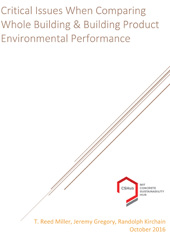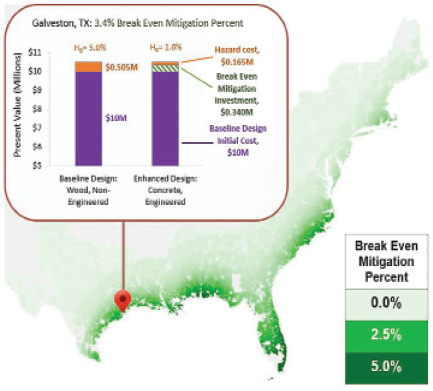After eight years as Massachusetts Institute of Technology Concrete Sustainability Hub executive director, Jeremy Gregory has transferred to a position with the newly formed MIT Climate and Sustainability Consortium. MIT officials credit his spearheading of impactful research, encouraging connections between lab members, fostering industry partnerships, and greatly expanding the CSHub’s reach and presence nationally and internationally. “His insight, clarity, and…
Read MoreTag: Concrete Sustainability Hub
Cambridge Collaboration
MIT Concrete Sustainability Hub enters a second decade set to further frame criteria driving building and construction decisions
Having secured another five-year industry commitment through 2024, the Massachusetts Institute of Technology Concrete Sustainability Hub (MIT CSHub) is prepared to take its innovative research to the next level in revolutionizing the way building and construction design decisions are made.
Read MoreLife-cycle perspective backs report on critical issues in building practices
A new report from the Massachusetts Institute of Technology-hosted Concrete Sustainability Hub (CSHub), Critical Issues When Comparing Whole Building and Building Product Environmental Performance, addresses key concepts in quantifying the environmental impact of buildings and products comprising them. It also makes recommendations for current and future building practices using life cycle assessment (LCA), and offers suggestions for research to advance future study and practice.
Read MoreCSHub at MIT develops hazard mitigation metric
The Concrete Sustainability Hub at Massachusetts Institute of Technology has developed Break Even Mitigation Percent (BEMP), a new tool to estimate the cost of weather hazards on a building. In a new research brief, “A break-even hazard mitigation metric,” CSHub staff finds that a $10 million non-engineered wood building is expected to face more than half a million dollars in hazard related damages over 50 years, while a $10 million engineered concrete building is expected to face only $165,000 over the same period.
Read MoreMIT researchers develop hazard mitigation metric for construction specs
Sources: National Ready Mixed Concrete Association, Silver Spring, Md.; Concrete Sustainability Hub at Massachusetts Institute of Technology, Cambridge; CP staff
The MIT-hosted Concrete Sustainability Hub has developed Break Even Mitigation Percent (BEMP), a new tool to estimate the cost of weather hazards on a building. In its July research brief, “A break-even hazard mitigation metric,” CSHub staff finds that a $10 million non-engineered wood building is expected to face more than half a million dollars in hazard related damages over 50 years, while a $10 million engineered concrete building is expected to face only $165,000 over the same period.
Read MoreMIT researchers: Marine species suggest blueprints for better concrete structures
In a project funded by outside parties and independent of the Concrete Sustainability Hub, Massachusetts Institute of Technology researchers are seeking to redesign concrete by following nature’s blueprints, contrasting cement paste with the structure and properties of bones, shells, and deep sea sponges. As they observe in the current Construction and Building Materials paper, “Roadmap across the mesoscale for durable and sustainable cement paste—A bioinspired approach,”such biological materials are exceptionally strong and durable, thanks in part to their precise assembly of structures at multiple length scales, from the molecular to the macro, or visible, level.
Read MoreMarine species represent blueprints for stronger, more durable concrete
Sources: Massachusetts Institute of Technology, Cambridge; CP staff
In a project funded by outside parties and independent of the Concrete Sustainability Hub, MIT researchers are seeking to redesign concrete by following nature’s blueprints, contrasting cement paste with the structure and properties of bones, shells, and deep sea sponges. As they observe in a current Construction and Building Materials paper, such biological materials are exceptionally strong and durable, thanks in part to their precise assembly of structures at multiple length scales, from the molecular to the macro, or visible, level.
Read MorePavement, materials specialist named Concrete Sustainability Hub co-director
Sources: Massachusetts Institute of Technology, Cambridge; CP staff
An engineer who researches the environmental and economic implications of materials selection in the manufacture and lifespan of products, Randolph Kirchain has been named co-director of the MIT-hosted Concrete Sustainability Hub (CSHub) alongside Franz-Joseph Ulm, professor of Civil Engineering.
Read MoreSizing up nano-scale materials
For the third year in a row, we visit a pavement project VCNA Prairie Material helped convert from all asphalt to partial (base slab) or 100-percent roller compacted concrete. More than a routine switch, the Maryhill Cemetery maintenance shop (pages 28-31) marks the commercial debut of RCC Surface Pro, a silica agent emanating from the field of nanotechnology, where particles are measured in billionths of a meter.
Read MoreMIT researchers model stronger cement on theory behind Corning Gorilla Glass
Sources: Concrete Sustainability Hub at Massachusetts Institute of Technology, Cambridge; Corning Inc., New York; CP staff
Borrowing from a ‘rigidity theory’ that has led Corning Inc. engineers to the high performance Gorilla Glass—its toughness in thin sections equal to smartphone and laptop computer screens—the Concrete Sustainability Hub is studying potential portland cement reformulation aimed at higher fracture resistance than current ASTM C 150 product.
Read More

